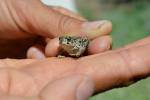Fish restoration effort reaches ‘bright spot’
Efforts to restore populations of endangered humpback chub in the Colorado River Basin appear to be working at one location in the Grand Canyon, a federal biologist said Monday.
"This is a bright spot," said Matthew Andersen, supervisory fish biologist at the U.S. Geological Survey's Grand Canyon Monitoring and Research Center.
He was referring to an area near the confluence of the Colorado and Little Colorado rivers where numbers of adult humpback chub rebounded by 50 percent between 2001 and 2008 after declines during the previous decade.
Andersen said biologists think the estimate of 7,650 adult humpback chub there probably resulted from a few factors, including removal of significant numbers of rainbow and brown trout that preyed on young humpbacks and competed with chubs for food. Between 2003 and 2006, rainbow trout numbers near the confluence were reduced by 80 percent.
Other possible factors are drought-induced warming of the main Colorado River channel and experimental releases of water from Glen Canyon Dam.
Scientists have been studying the humpback chub since it was first recorded in the Grand Canyon in 1947.
The freshwater fish can live up to 40 years and is found only at the confluence of rivers in the Grand Canyon, which is part of the lower basin of the Colorado River, and at five locations in the upper basin, upstream of Lees Ferry, Ariz.
The fish was added to the list of endangered species in 1967.
For a while, the U.S. Fish and Wildlife Service kept a refuge population at Willow Beach National Fish Hatchery on Lake Mohave. The intent was to have a reserve population in captivity in case something happened to wild populations.
Humpback chub at the Willow Beach hatchery were moved about two years ago to Dexter National Fish Hatchery and Technology Center in New Mexico, said U.S. Fish and Wildlife Service spokesman Jeff Humphrey.
He said to change the status of the humpback chub from endangered to threatened, biologists would need to document five years of increasing population trends at one location each in the lower and upper Colorado River Basin.
It still would be federally protected as a threatened species.
Contact reporter Keith Rogers at krogers@reviewjournal.com or 702-383-0308.




























